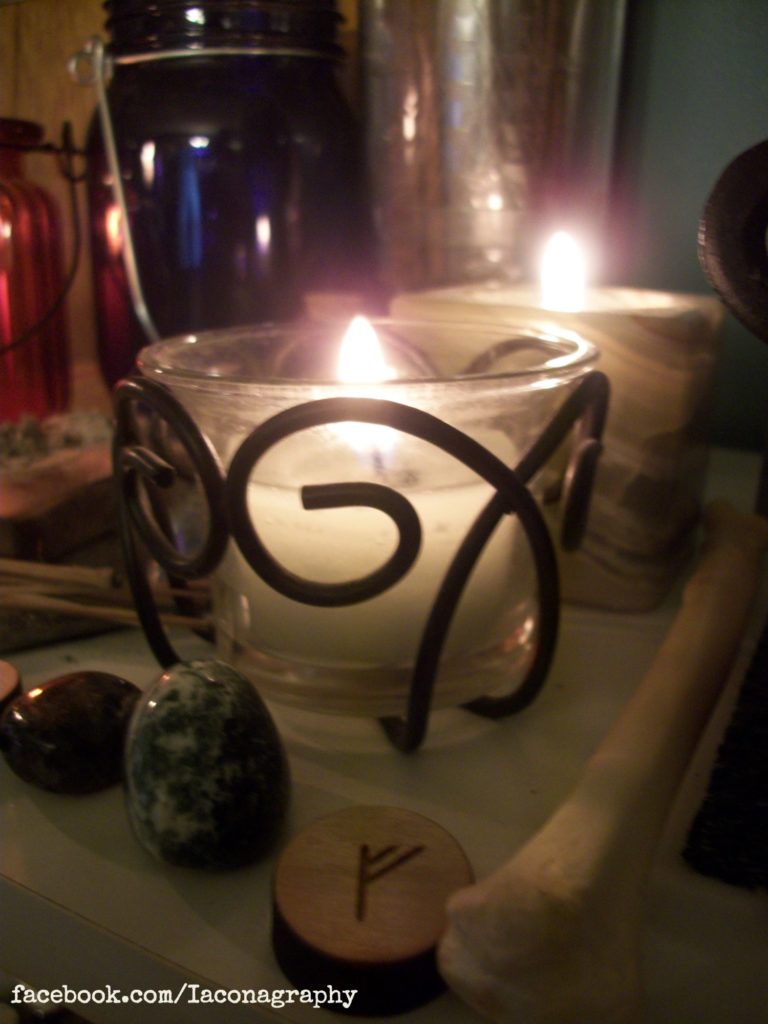Reclaiming the Heidhrinn Heart: Are We Pagan, or Not?

Go into any Heathen/Norse Traditional group and call our faith-practice Pagan, and see what happens. Go ahead: I dare ya! I’ll wait here, and hold your mead….
Many Norse Traditionalists react violently to the “dreaded P-word”; screams of “we are not an earth-based, tree-hugging tradition!” ensue. Yet, history paints a very different picture, which I find interesting, given that most of those same people who are reacting so violently honestly consider themselves to be Historical Reconstructionists.
What does it actually mean, that “dreaded P-word”, Pagan?
Pagan: follower of a non-dogmatic, polytheistic or pantheistic system of faith that venerates Ancestors and land-spirits. (Paraphrased from The Pagan Federation International.)
Followers of a Norse Path are (supposedly) non-dogmatic. So, why do I have supposedly in parentheses there? Well, let’s define that word, too, shall we?
dogmatic: characterized by or given to the expression of opinions very strongly or positively as if they were facts; authoritatively holding to a doctrine or body of doctrines concerning faith and/or morals which are then formally proclaimed by a ruling or majority religious body.
I have supposedly in parentheses up there because you literally cannot toss a pebble into the pond of most established Norse Traditional groups without hitting multiple people who routinely express opinions very strongly or positively as if they were facts, and then behave in an authoritative manner concerning faith, morals, and the very definition of “what it means to be Heathen”. In other words, tons of people who are excited to be able to inform you that you’re doing it wrong! That, my friends, is dogmatic behavior at its finest. So if we only used that portion of the definition of what it means to be Pagan, then most of those people who react so violently to the “dreaded P-word” would be absolutely right to do so. In that sense, no, most followers of a Norse Path are decidedly not Pagan, because they are not non-dogmatic.
This “you’re doing it wrong culture” often bleeds over into things like “Christian bashing”, largely based on media depictions of “one, true, right, and only way Vikings” who patently did not exist, from a historical perspective. Unfortunately, not all of those sentiments are fostered solely from media depictions; much of this venom also stems from people who have been profoundly injured by their fundamentalist Christian pasts, or by “wrong-minded Christians” whom they have encountered over the course of their own personal lives. Newsflash: fighting dogma with dogma resolves nothing!
Supporting the myth of the “one, true, right, and only way Viking” is a slap in the face to a faith that claims to be even mildly Historical Reconstruction-ish, much less pure Reconstructionist. What is this myth of which I speak? It involves things like “we do not bow to our Gods” and “our Gods do not ask us to kneel”, which is patently disproven in the written record, specifically in Kjalnesinga Saga, in the story of Bui and Thorstein. It also involves the image of the “conquering Viking” who “makes war” on Christianity by specifically targeting churches due to religious conviction. While we cannot go back in time and effectively read the minds of our Viking Ancestors to fully know motivation, their most likely reason for actually targeting churches was monetary, not faith-based. Quite simply put: in the medieval period, the Church was the most wealthy institution on the planet, which meant that if you were looking for gold and silver, a church was the most likely place to find it in bulk.
Followers of a Norse Path are polytheistic/pantheistic. Face it: our choice of the Norse Pantheon as the Gods at the core of our faith system is precisely what makes us Norse Traditionalists in the first place! We are both polytheistic and pantheistic, whether we are decidedly hardline (Loki is Loki and only Loki, none of this aspecting or comparative mythology business, y’all!) about that, or not.
At its core, this Heidhrinn faith is a polytheistic religion; whether one chooses to explore their faith as a hard polytheist or as a soft polytheist (as I do), there are ultimately “many Gods for many things”, or, to come from a slightly more softly polytheistic stance: “many faces of God for many things.” —Norse Witch: Reclaiming the Heidhrinn Heart, by Connla Freyjason
Followers of a Norse Path practice Ancestor veneration. We blot them, we pray for them, we talk to them, we keep space for them on our altars; heck, some of us have entirely separate altars specifically for the Ancestors!
Ultimately, we venerate the Ancestors because, quite simply, without them, we wouldn’t be here. Ancestor veneration is one more expression of the “a gift for a gift” attitude of gratitude which runs its deep thread throughout Norse practice, forming one of its strongest cornerstones. You did not get here all by yourself. Others came before you, and they facilitated your being here, and you would be deeply remiss in not offering them gratitude for that fact. —Norse Witch: Reclaiming the Heidhrinn Heart, by Connla Freyjason
Followers of a Norse Path venerate land-spirits. The Landvaettir play a crucial role in Norse practice and historically always have: one need look no further than the dragons on the prows of Viking ships for proof! Most of the people who sneer at the word pagan being applied to their Norse practice are also seriously “hung up” on being “modern day Vikings”. Well, hate to break it to them: those dragons weren’t there just so our Ancestors could “look tough”; they served a very real magickal purpose: to ward off or frighten away any ill-meaning Landvaettir. In fact, our Ancestors believed so strongly in the capacity of these figureheads to frighten the Landvaettir that it was forbidden by Icelandic law for a ship to enter its home harbor unless the dragon was first removed. Clearly, the Ancestors understood that veneration of the land–and its Landvaettir–was not “squishy” or “fluffy”; no “tree-hugging” was required for healthy respect and veneration.
While most of us hopefully go through life at least noticing the birds in the trees or the occasional squirrel that crosses our path, or perhaps even spend a lot of time with the family dog or family cat, a deeper relationship with the Landvaettir requires, as one may have guessed by now, a deeper relationship with the land itself. Unfortunately, we live in a society where few people notice the land unless it is in someone’s way: we notice the land when we trip over a rock or bump into a tree, and that land causes us pain; we notice the land when suddenly a resource is threatened, or when someone’s lifestyle or livelihood is endangered by some resource (such as in the case of the Dakota Pipeline, or the Gulf Oil Spill of a few years ago). We notice the land when it becomes something we wish to acquisition for ourselves (as in the selling and buying of a home or other property). But on a day to day basis, how often do we really stop to notice the land itself, or consider our relationship to and with it and its spirits? —Norse Witch: Reclaiming the Heidhrinn Heart, by Connla Freyjason
So, yes, Virginia, Heidhrinns and all those others who are truly practicing a Norse-based path are, in fact, Pagan! We are (supposed to be) non-dogmatic, polytheistic/pantheistic practitioners/believers who venerate the Ancestors and the spirits of the land. Just because some dude-bro somewhere along the way decided all Pagans were “fluffy” doesn’t make that the definition of what it actually means to be Pagan. Stop getting it twisted, and let’s own who and what we are! Perhaps then we can work on developing a voice in the larger Pagan community, build bridges, and gain allies in a time when we desperately need less division and more inclusivity if we wish for our faith to survive unmarred by racism, gender-exclusion, and all the other negativity which is encroaching daily upon our practice.

